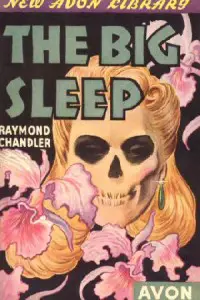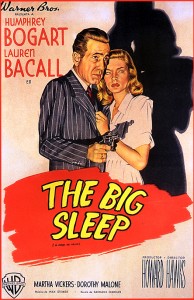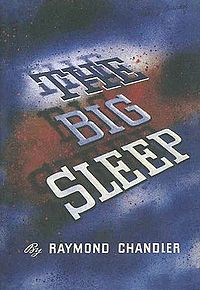The Big Sleep—Dashiell Hammett–1939–in print
 I admit, the film is one of my all time favorites. I will watch it each and every time it plays on Turner Classic Movies. Happily, Mr. Turner didn’t colorize this film–or if he did, they don’t bother ruining our viewing pleasure by showing that version. I can enter at the middle, and become glued to the set, or even at the very end, when there’s just a few more moves to be made, and I’ll still opt to watch it rather than some first run program. I love it for the very reason some critics hate it–the convoluted plot. So layered, that even Chandler was hard put to explain whodunit for one of the murders in the book and on screen. I love the actors, naturally–I mean, how could one not love Bogart and Bacall–and wow–the sister to Bacall’s character, Martha Vickers, steals the show–which is why they went back and added more scenes for Bacall to shine in. Character actors galore, and an early Dorothy Malone add up to the perfect mystery film. And lest I forget, the biblio aspect of the story is just the scotch in old man Sternwood’s glass, he can’t drink.
I admit, the film is one of my all time favorites. I will watch it each and every time it plays on Turner Classic Movies. Happily, Mr. Turner didn’t colorize this film–or if he did, they don’t bother ruining our viewing pleasure by showing that version. I can enter at the middle, and become glued to the set, or even at the very end, when there’s just a few more moves to be made, and I’ll still opt to watch it rather than some first run program. I love it for the very reason some critics hate it–the convoluted plot. So layered, that even Chandler was hard put to explain whodunit for one of the murders in the book and on screen. I love the actors, naturally–I mean, how could one not love Bogart and Bacall–and wow–the sister to Bacall’s character, Martha Vickers, steals the show–which is why they went back and added more scenes for Bacall to shine in. Character actors galore, and an early Dorothy Malone add up to the perfect mystery film. And lest I forget, the biblio aspect of the story is just the scotch in old man Sternwood’s glass, he can’t drink.
But this is about the novel the film was based on–and naturally, they aren’t the same. Close in some parts, but not all. Philip Marlowe, private eye, goes to the palatial home of General Sternwood, an elderly ill man of wealth. He’s called into a hothouse, the humidity is stifling, Sternwood wants Marlowe to look into the blackmailing of his wild younger daughter, Carmen. She had been blackmailed by someone before named Brody, but now it seems as though a bookman named Geiger was the one putting on the pressure. Sternwood’s older daughter, Vivian, is married to the missing Rusty Regan. Vivian questions Marlowe to ascertain if he’s been hired to find Regan.
Marlowe visits Geiger’s bookstore. Here’s my favorite part of the film–but for the life of me I can’t remember if it’s in the book–I doubt it. Marlowe pretends to be a book collector (Bogart) he pulls his glasses down, speaking in an odd manner, to create a character that he figures would be like a book collector. It’s hilarious, and one of the few times I’ve seen Bogart do anything other than Bogart. In the film he asks specific questions about a couple of rare books, the clerk has no idea what he’s talking about. He goes across the street to another bookstore–yes, it’s not complete fiction to believe back in the 40s two bookstores existed across from one another–asks the same questions, this time with answers, and then Nancy Malone and Bogie pull down the shades and spend a little time in the back, uh, researching rare books, ha.
Malone and Bogie pull down the shades and spend a little time in the back, uh, researching rare books, ha.
Anyway, back to the literary classic, Marlowe realizes Geiger’s is nothing but a front for a porno joint. He stakes out Geiger’s private residence, sees Carmen Sternwood enter, hears shrieks and gunshots, runs in to find Carmen naked as a jailbird, Geiger, dead–and a camera empty of the film taken of Carmen and her birthday suit.
From here on in, the story becomes more twisted than a Philly pretzel, and it wouldn’t be fun for the minuscule percentage of people who haven’t read the book or seen the film to give it away. A main difference is Marlowe and Vivian falling in love in the film version, as opposed to the book. And the big finish of the film isn’t part of the written story either.
Chandler apparently pieced this novel together from his various stories–creating an entirely new cast of characters, but some of the settings and story lines remained the same. This is a reason some believe the murder of the chauffeur isn’t known, because Chandler had forgotten to add the solution to this problem when he consolidated the stories.
 Chandler was no Christie–the plot was secondary to the atmosphere and characters–my feeling is that everything was secondary to atmosphere—-the seedy streets of Los Angeles. Chandler was not what one thinks of as an hard-boiled writer of crime stories. He smoked a pipe, wore white gloves when he typed and most telling of all, to some misogynists–he was married to a woman many years his senior, and in great Yoko Ono fashion, she was his ruination. In every bio I read online, they make a huge point of Cissy being 18 years his senior. I have never seen a bio of a man married to a younger woman with the amount of years stated in bold that she was his junior. Cissy’s age prompts many to believe him to be controlled by his wife–and a couple of his female friends believed he was a latent homosexual. That’s right–only closeted males would marry a woman soooo much older, right?
Chandler was no Christie–the plot was secondary to the atmosphere and characters–my feeling is that everything was secondary to atmosphere—-the seedy streets of Los Angeles. Chandler was not what one thinks of as an hard-boiled writer of crime stories. He smoked a pipe, wore white gloves when he typed and most telling of all, to some misogynists–he was married to a woman many years his senior, and in great Yoko Ono fashion, she was his ruination. In every bio I read online, they make a huge point of Cissy being 18 years his senior. I have never seen a bio of a man married to a younger woman with the amount of years stated in bold that she was his junior. Cissy’s age prompts many to believe him to be controlled by his wife–and a couple of his female friends believed he was a latent homosexual. That’s right–only closeted males would marry a woman soooo much older, right?
Chandler and Hammett are considered the godfathers of hard-boiled detective stories, and I’ve no reason to conclude otherwise. The Big Sleep is a must read, see, and then some, for the crime fiction lover, whether one believes this particular title is his best or not.
Don’t forget to check out the list of the Best Mysteries of All Time

excellent film worth watching.
http://hizlidizifilm.com